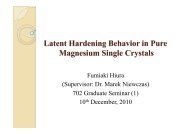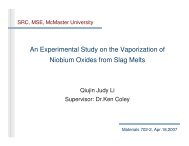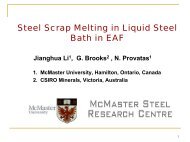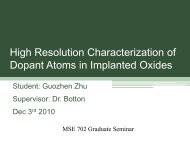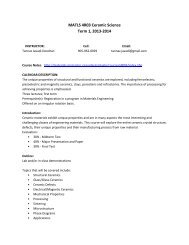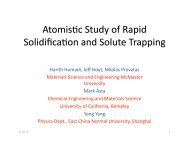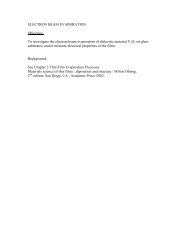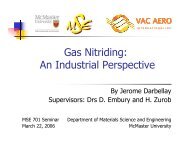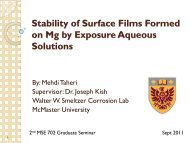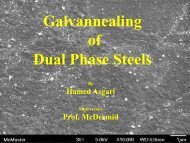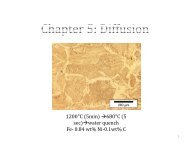Oxidation Growth Of SiO2 On Silicon - Course Notes
Oxidation Growth Of SiO2 On Silicon - Course Notes
Oxidation Growth Of SiO2 On Silicon - Course Notes
You also want an ePaper? Increase the reach of your titles
YUMPU automatically turns print PDFs into web optimized ePapers that Google loves.
4L04 <strong>Oxidation</strong> of <strong>Silicon</strong>This experiment will demonstrate thin film formation through oxidation of silicon to form a <strong>SiO2</strong> thinfilm on silicon.Background reading:The oxidation of silicon is a diffusion process as follows: Due to the relatively open structure of<strong>SiO2</strong>, oxygen molecules or water molecules will diffuse through the growing <strong>SiO2</strong> layer andreach the silicon surface, whereupon these molecules will form <strong>SiO2</strong>.Under exposure to oxygen(1), a silicon surface oxidizes to form silicon dioxide (<strong>SiO2</strong>). Nativesilicon dioxide is a high-quality electrical insulator and can be used as a barrier material duringimpurity implants or diffusion, for electrical isolation of semiconductor devices, as a componentin MOS transistors, or as an interlayer dielectric in multilevel metallization structures such asmultichip modules. The ability to form a native oxide was one of the primary processingconsiderations which led to silicon becoming the dominant semiconductor material used inintegrated circuits today.Thermal oxidation of silicon is easily achieved by heating the substrate to temperatures typicallyin the range of 900-1200 degrees C. The atmosphere in the furnace where oxidation takes placecan either contain pure oxygen or water vapor. Both of these molecules diffuse easily through thegrowing <strong>SiO2</strong> layer at these high temperatures. Oxygen arriving at the silicon surface can thencombine with silicon to form silicon dioxide. The chemical reactions that take place are eitherfor so-called "dry oxidation" orfor "wet oxidation". Due to the stoichiometric relationships in these reactions and the differencebetween the densities of Si and <strong>SiO2</strong>, about 46% of the silicon surface is "consumed" duringoxidation. That is, for every 1 um of <strong>SiO2</strong> grown, about 0.46 um of silicon is consumed (seeFigure 1).
Oxide <strong>Growth</strong> KineticsInitially, the growth of silicon dioxide is a surface reaction only. However, after the <strong>SiO2</strong>thickness begins to build up, the arriving oxygen molecules must diffuse through the growing<strong>SiO2</strong> layer to get to the silicon surface in order to react.A popular model for the oxide growth kinetics is the "Deal/Grove" model. This model isgenerally valid for temperatures between 700 and 1300 C, partial pressures between 0.2 and 1.0atmospheres, and oxide thicknesses between 0.03 and 2 microns for both wet and dry oxidation.To understand this model, consider Figure 2, and let:Cg = concentration of oxidant molecules in the bulk gasCs = concentration of oxidant molecules immediately adjacentto the oxide surfaceCo = equilibrium concentration of oxidant molecules at theoxide surfaceCi = concentration of oxidant molecules at the Si/<strong>SiO2</strong>interface
Note that: 1) Cg > Cs (due to depletion of the oxidant atthe surface)2) Cs > Co (due to the solubility limits of <strong>SiO2</strong>)The oxidizing species are transported from the bulk gas to the gas/oxide interface with flux F1(where flux is the number of molecules crossing a unit area per unit time). The species aretransported across the growing oxide toward the silicon surface with flux F2, and react at theSi/<strong>SiO2</strong> interface with flux F3. Mathematically:F1 = flux of oxidant from gas -> surface(where Hg = the gas phase mass transfer coefficient)F2 = flux through the oxide layer
(where D is the diffusivity of the oxidant molecule in <strong>SiO2</strong>)If we asume a linear concentration gradient inside the oxide layer, then:(where d is the current value of the oxide thickness)Finally:(where Ks = the rate constant for the surface chemical reaction)Now let's look at F1 more closely. By Henry's Law:
where H is Henry's Law constant, C* is the equilibrium concentration of oxidant molecules inthe bulk <strong>SiO2</strong>, and Ps and Pg are the partial pressures of the oxidant molecules adjacent to the<strong>SiO2</strong> surface and in the bulk gas, respectively. From the Ideal Gas Law, we have:where k is Boltzman's constant and T is the temperature in degrees K. Therefore, F1 can be rewrittenas:where h = Hg/HkT. At steady-state, all three fluxes should be equal. In other words,
If the oxidation growth rate depends only on the supply of oxidant to the Si/<strong>SiO2</strong> interface, it issaid to be "diffusion controlled. Under this condition, D is close to zero. Therefore:If, on the other hand, there is plenty of oxidant at the interface, the growth rate depends only onthe reaction rate. This situation is called "reaction-controlled." In this case, D appoaches infinity,and:Now, we are finally ready to compute the growth rate itself. Let N1 be the number of oxidantmolecules per cubic cm incorporated into the oxide layer. Then, we can write the followingdifferential equation:
Under the boundary condition that d = 0 when t = 0, we can solve the first order differentialequation to obtain:and di is the initial oxide thickness. For short times, the growth rate is reaction limited, and theoxide thickness is approximately:For longer times, growth is diffusion-limited, and the approximation used is:A and B are constants which correspond to the oxidation conditions (i.e. - temperature and wet ordry). They can typically be looked up in tables.
Specific reading:Read over the EP4U04 Lab manual, which is available through the McMaster web page within thedepartment of Engineering Physics as well as appropriate safety information (2). This lab describessemiconductor device fabrication. We will not be making complete semiconductor devices, however itis useful to see the oxide growths that we will perform in the context of semiconductor devicefabrication.Pay specific attention to the following sections:Page 3, safetyPage 4-5, silicon cleanlinessPage 6, oxidation of siliconPage 22-24:1) Wafer cleaning and field oxide growth2) Etching of oxideSee also the files in 3) ona) Oxide thickness versus growth conditions, (dry O2 and wet O2)b) <strong>Silicon</strong> cleaning proceduresc) Colour Table of <strong>SiO2</strong> on SiProcedure:1) Clean and prepare silicon wafer pieces as detailed in 3).2) Grow oxide layer at 1200C in Dry Oxygen for 1 hour, 2 hours and 3 hours respectively on threesamples.3) Verify the oxide thicknesses using the colour table.4) Using spin-on photoresist, etch a step into each sample and confirm the oxide thickness usingthe Alpastep.Discussion:1) Review the theory of oxide growth on silicon. Using appropriate coefficients and literaturevalues, predict the thickness values you obtained using appropriate equations taken from theabove section. Compare your results to the predicted values. Also, compare the values on p535of Streetman (4) to the calculated value.2) Describe the theory of optical interference in thin films. Show how the colour of light reflectedfrom a hypothetical transparent thin film (refractive index n) deposited on an ideal metalsurface (100% reflective) would behave as a function of thin film thickness. Assume a whitelight source. Compare these results to your experimental observations, and discuss. What
differences between your simple model and the actual results on silicon do you need toconsider?3) <strong>Silicon</strong> may also be oxidized using water vapour. Compare the predicted rate of oxide growthusing water using the same temperature and time conditions, and compare to dry oxygengrowth. Explain the difference in growth rates.4) Describe the structure and basic operation of a silicon Metal-Oxide-Semiconductor Field EffectTransistor (MOSFET). The MOSFET is by far the most important transistor type used in siliconintegrated circuits, and it traditionally relies on <strong>SiO2</strong> growth on silicon. More recently (after2007), other oxide materials are being used to replace <strong>SiO2</strong> due to their higher dielectricconstants.References:1) http://www.ece.gatech.edu/research/labs/vc/theory/oxide.html2)http://engphys.mcmaster.ca/undergraduate/outlines/4u04/4U4SS-pdf-2005.pdf3) http://engphys.mcmaster.ca/undergraduate/outlines/4u04/4U4SS-appendix-2.pdf4) B.G. Streetman and S.Banerjee, Solid State Electronic Devices, 5 th edition, Prentice Hall, 2000


